9 Best Herbal Teas For Period Cramps
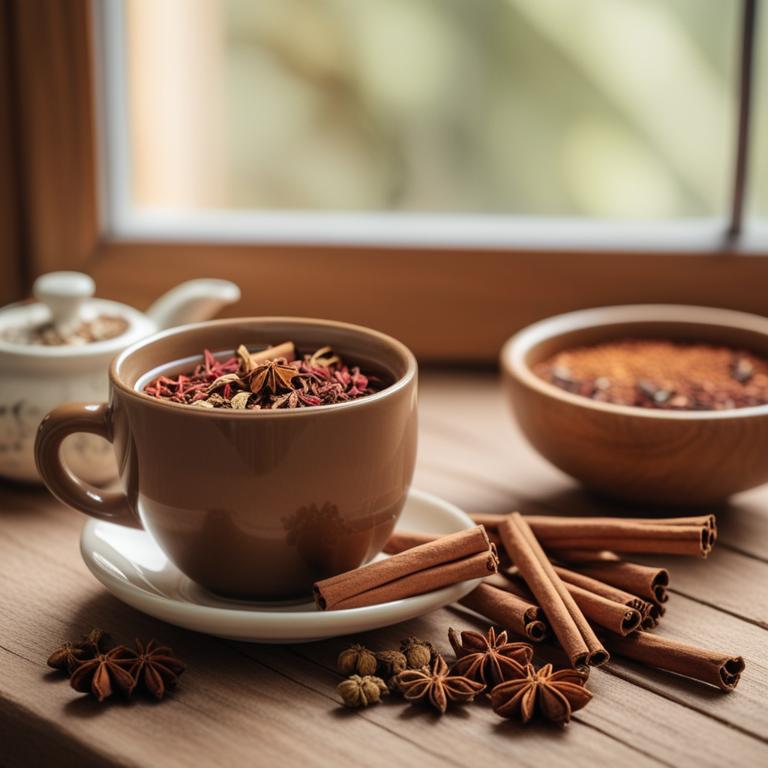
Herbal teas for period cramps are a type of natural remedy made from various herbs and plants that help alleviate menstrual cramp discomfort.
These teas can treat period cramps because they contain anti-inflammatory properties and essential oils that soothe the uterus and ease muscle spasms.
Examples of herbal teas used to treat period cramps include ginger tea, which reduces inflammation and relaxes the muscles; peppermint tea, which cools the body and calms the mind; chamomile tea, which promotes relaxation and reduces anxiety; raspberry leaf tea, which helps regulate menstrual cycles and eases cramps; and dandelion tea, which reduces bloating and water retention.
Additionally, other herbal teas such as cramp bark tea, red clover tea, and licorice root tea have also been used to treat period cramps due to their anti-inflammatory and hormone-balancing properties.
Related Study
According to the study, teas for period cramps, such as green tea, may provide an effective and safe treatment for pain relief due to its antioxidant and anti-inflammatory properties.
Below there's a list of the 9 best herbal teas for period cramps.
Table of Contents
Also, you may be interested in...
Today Free Bonus!
The Ultimate Herb Drying Checklist
(For Long-Lasting Powerful Medicinal Effect)
How to easily dry herbs that don't mold and that keep their strong medicinal power for more than 1 year.
1. Glycyrrhiza glabra teas

Glycyrrhiza glabra teas, derived from the roots of the licorice plant, have been traditionally used to alleviate period cramps due to their anti-inflammatory and spasmolytic properties.
The bioactive constituents, such as glycyrrhizin and flavonoids, help to relax uterine muscles, reducing cramp intensity and frequency.
These teas also have a soothing effect on the nervous system, reducing stress and anxiety that may exacerbate period cramps.
Regular consumption of Glycyrrhiza glabra teas may provide relief from period cramps, improve overall menstrual health, and promote a sense of well-being in individuals experiencing this common gynecological symptom.
Recipe:
- Gather 1 cup of fresh or dried Glycyrrhiza glabra roots, 2 cups of water, and a tea infuser or a heat-resistant cup.
- Rinse the Glycyrrhiza glabra roots and chop them into smaller pieces.
- Combine the chopped roots and water in the tea infuser or heat-resistant cup, and bring the mixture to a boil.
- Reduce the heat to low and let the mixture simmer for 5-7 minutes, then strain the liquid into a cup.
- Drink 1 cup of the tea 2-3 times a day, or as needed to relieve period cramps.
Glycyrrhiza glabra teas can be used to treat period cramps, but possible side effects include headaches, dizziness, and nausea due to its potential to interact with other medications and affect blood pressure.
To use Glycyrrhiza glabra teas safely, it is recommended to consume them in moderation and avoid taking them in large quantities or for extended periods, as this may lead to excessive potassium loss and other adverse effects.
Glycyrrhiza Glabra Tea on Amazon
Pukka Herbal Teas Licorice and Cinnamon - 20 Bags, 20 Count
Disclaimer: We earn a commission if you click this link and make a purchase at no additional cost to you.
2. Zingiber officinale teas

Zingiber officinale teas, also known as ginger tea, have been traditionally used to treat period cramps due to their anti-inflammatory and analgesic properties.
The bioactive constituents of ginger, such as gingerols and shogaols, help to reduce prostaglandins, which are hormone-like substances that cause pain and inflammation in the uterus.
By reducing prostaglandins, ginger tea helps to alleviate period cramps and provide relief from associated symptoms such as nausea and bloating.
The benefits of using ginger tea to treat period cramps include reduced pain, improved mood, and enhanced overall well-being.
Recipe:
- Gather 1 cup of water and 1 tablespoon of dried Zingiber officinale root.
- Heat the water in a pot until it boils.
- Add the dried Zingiber officinale root to the boiling water.
- Reduce heat and let it simmer for 5-7 minutes.
- Strain the tea and drink 1/2 cup, 2-3 times a day as needed.
Zingiber officinale teas can be effective in alleviating period cramps, but using them may result in side effects such as stomach upset, nausea, and diarrhea due to the high ginger content.
Precautions to take when using these teas include starting with small amounts and gradually increasing the dose, avoiding consumption during pregnancy and breastfeeding, and not taking them with blood-thinning medications.
Zingiber Officinale Tea on Amazon
FGO Organic Ginger Tea, 100 Count, Eco-Conscious Tea Bags, Caffeine Free, Packaging May Vary (Pack of 1)
Disclaimer: We earn a commission if you click this link and make a purchase at no additional cost to you.
3. Paeonia lactiflora teas
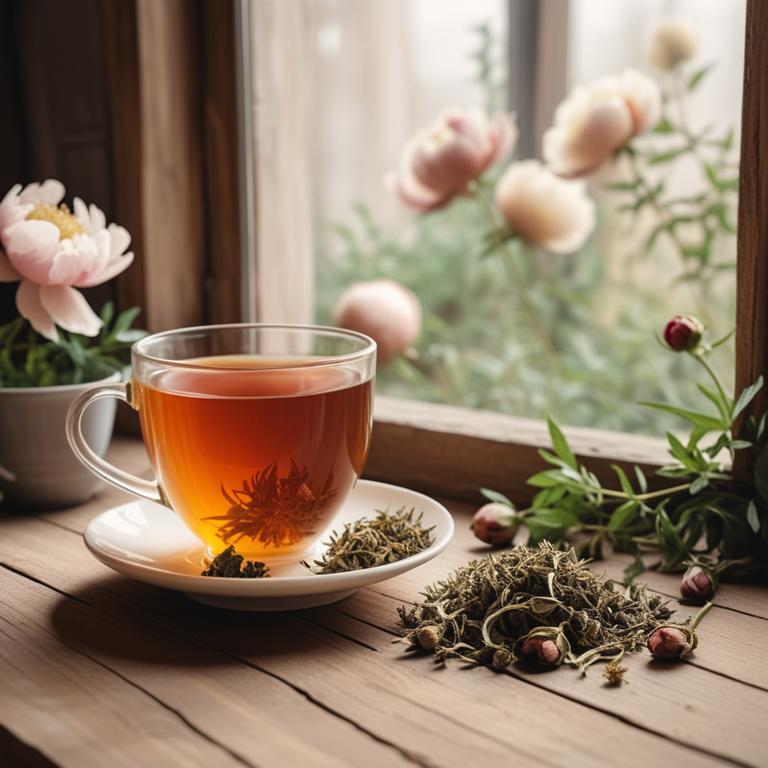
Paeonia lactiflora teas have been traditionally used to treat period cramps due to their anti-inflammatory, antispasmodic, and analgesic properties.
The bioactive constituents, including peonidin andpeonin, in Paeonia lactiflora teas help to relax uterine muscles, reduce prostaglandin production, and alleviate pain associated with menstrual cramps.
By reducing inflammation and relaxing uterine muscles, Paeonia lactiflora teas provide relief from period cramps, making it a beneficial herbal preparation for women experiencing this ailment.
The benefits of using Paeonia lactiflora teas to treat period cramps include reduced pain and discomfort, improved menstrual regularity, and a natural alternative to conventional pain management medications.
Recipe:
- Gather 1 cup of fresh or dried Paeonia lactiflora flowers and 1 cup of boiling water.
- Steep the flowers in the boiling water for 5-7 minutes. Then, strain the mixture through a fine-mesh sieve into a cup.
- Add 1 tablespoon of honey to the tea if desired for sweetness.
- Drink the tea 2-3 times a day for relief from period cramps.
- Store any leftover tea in the refrigerator for up to 24 hours.
Paeonia lactiflora teas can be an effective herbal remedy for treating period cramps, but it may also cause side effects such as dizziness, nausea, and stomach upset due to its sedative properties and potential interaction with certain medications.
To use Paeonia lactiflora teas safely, it is recommended to start with small amounts and gradually increase the dose, avoid using it with other sedatives or medications, and refrain from consuming it before driving or operating heavy machinery.
4. Valeriana officinalis teas
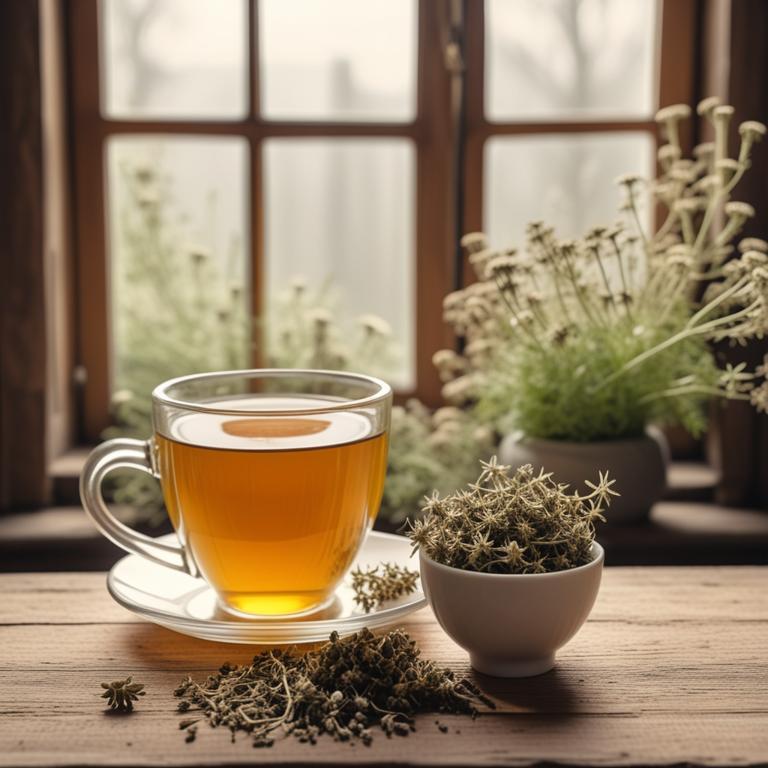
Valeriana officinalis teas, also known as valerian root tea, have been traditionally used to alleviate period cramps due to their sedative and anti-spasmodic properties.
This herbal preparation helps to treat period cramps by promoting relaxation, reducing muscle spasms, and improving sleep quality, thereby reducing overall discomfort.
The bioactive constituents of valerian root tea, including isovaleric acid, valerenic acid, and valepotriates, contribute to its therapeutic effects, acting as a natural pain reliever and muscle relaxant.
The benefits of valerian root tea in treating period cramps include reduced severity and frequency of cramps, improved sleep quality, and enhanced overall well-being, making it a popular natural remedy among women experiencing menstrual cramps.
Related Study
According to "Journal of family medicine and primary care", Valeriana officinalis teas for period cramps may be a useful supportive therapy in combination with conventional medications to target both pelvic pain and neuronal symptoms associated with dysmenorrhea.
Recipe:
- Gather 1 cup of fresh or dried Valeriana officinalis root.
- Use a tea infuser or a heat-resistant cup to steep 1-2 tablespoons of the root in 1 cup of boiling water for 5-7 minutes.
- Strain the liquid and discard the root. Let the tea cool down to a comfortable temperature.
- Add honey or lemon to taste, if desired. Some people find that a squeeze of lemon helps with the flavor.
- Drink the tea 2-3 times a day, or as needed to manage period cramps.
Valeriana officinalis teas can be used to treat period cramps, but possible side effects may include drowsiness, dizziness, and stomach upset due to its sedative properties.
Precautions when using this herbal preparation include taking it in moderation, avoiding use in the morning or before driving, and being aware that it may interact with certain medications, such as sedatives and antidepressants, which could exacerbate side effects.
Valeriana Officinalis Tea on Amazon
Frontier Co-op Cut and Sifted Valerian Root 1lb, Kosher - for Valerian Root Tea, DIY Supplement Capsules, Bedtime Formulas and Sleep Pillows
Disclaimer: We earn a commission if you click this link and make a purchase at no additional cost to you.
5. Lavandula angustifolia teas

Lavandula angustifolia teas, also known as English lavender, have been used for centuries to alleviate period cramps due to their analgesic and anti-inflammatory properties.
The bioactive constituents, including linalool and linalyl acetate, help to relax the uterine muscles and reduce prostaglandin production, which are responsible for the pain and discomfort associated with menstrual cramps.
By consuming Lavandula angustifolia teas, women can experience relief from period cramps, improved mood, and reduced anxiety.
The benefits of using Lavandula angustifolia teas to treat period cramps include a natural, non-invasive, and cost-effective approach to managing symptoms, promoting overall well-being and quality of life.
Recipe:
- Gather 1 cup of fresh Lavandula angustifolia flowers or 1 teaspoon of dried flowers.
- Heat 1 cup of boiling water in a tea kettle or pot.
- Add the Lavandula angustifolia flowers to a cup or teapot.
- Pour the hot water over the flowers and let it steep for 5-7 minutes.
- Strain the tea and drink 1 cup, 2-3 times a day to help with period cramps.
Lavandula angustifolia teas can be a natural remedy to alleviate period cramps, but consuming it may lead to side effects such as dizziness, nausea, and headaches due to its sedative properties.
To use Lavandula angustifolia teas safely, it is recommended to consume it in moderation, avoid driving or operating heavy machinery after consumption, and refrain from drinking it if you are pregnant or breastfeeding.
Lavandula Angustifolia Tea on Amazon
Tiesta Tea - Lavender Chamomile Herbal Tea | Loose Leaf | Calming Blend with Chamomile and Lavender | Caffeine-Free Herbal | Great for Hot or Iced Brews | Resealable Bulk Pouch, 200 Cups | 8 Ounce
Disclaimer: We earn a commission if you click this link and make a purchase at no additional cost to you.
6. Angelica archangelica teas
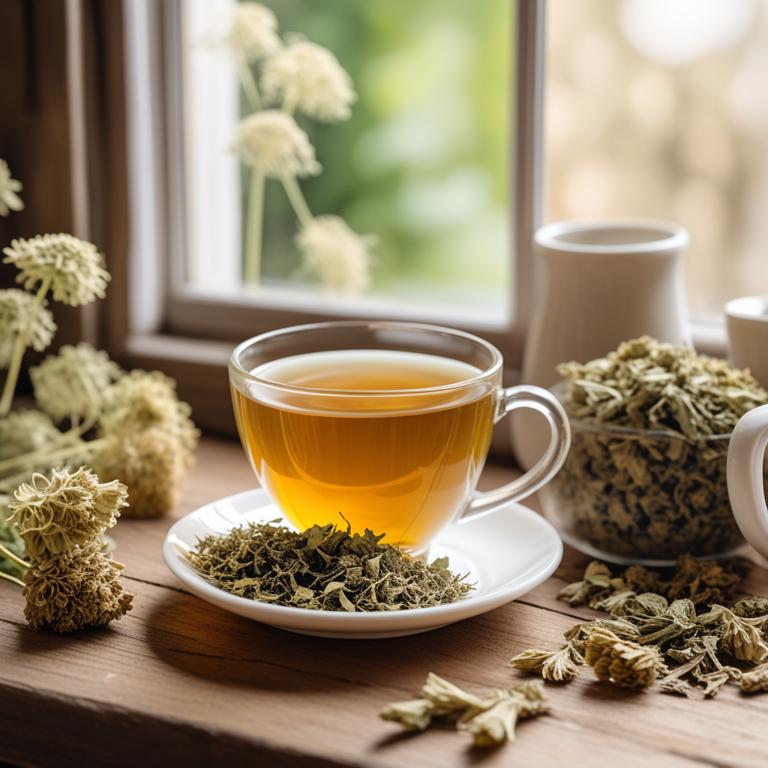
Angelica archangelica teas have been traditionally used to treat period cramps, offering relief from menstrual discomfort and pain.
The anti-inflammatory and antispasmodic properties of this herbal preparation help to reduce muscle cramps and spasms associated with menstruation, providing a natural and safe alternative to over-the-counter pain medications.
The bioactive constituents, including ferulic acid, isorhapontigenin, and sesquiterpenes, have been shown to possess analgesic and anti-inflammatory properties, which contribute to the relief of period cramps.
By consuming Angelica archangelica teas, women can experience the benefits of reduced pain, improved mood, and enhanced overall well-being during their menstrual cycle.
Recipe:
- Gather 1 tsp dried Angelica archangelica root and 1 cup boiling water.
- Steep the Angelica archangelica root in the boiling water for 5-7 minutes.
- Strain the mixture into a cup using a tea strainer or cheesecloth.
- Add 1 tsp honey (optional) to the tea and stir well.
- Drink the tea as needed to help relieve period cramps.
Angelica archangelica teas can be used to treat period cramps, but some possible side effects may include allergic reactions, such as skin rashes or itching, as well as interactions with medications like blood thinners, which can increase the risk of bleeding.
To use Angelica archangelica teas safely, it is recommended to start with a small dose and gradually increase it, and to avoid using it during pregnancy or breastfeeding, as well as with conditions that affect the kidneys or liver.
7. Foeniculum vulgare teas
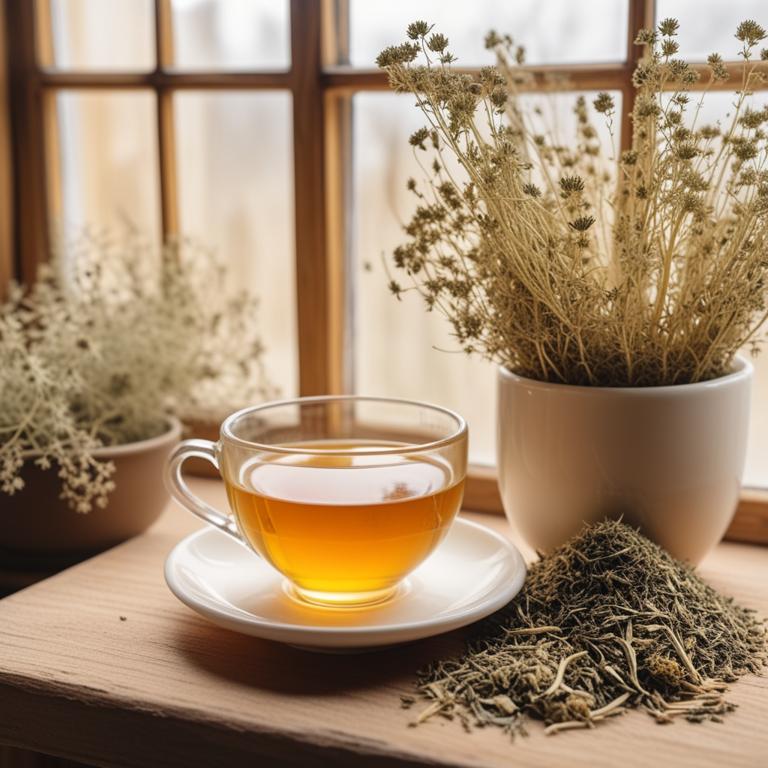
Foeniculum vulgare teas, also known as anise or fennel tea, have been traditionally used to treat period cramps due to their anti-inflammatory, antispasmodic, and anticonvulsant properties.
The tea's bioactive constituents, including anethole, fenchone, and estragole, help to relax the uterine muscles, reduce prostaglandin production, and alleviate cramping sensations.
By consuming Foeniculum vulgare teas, women can experience relief from period cramps, bloating, and other symptoms associated with PMS, thereby improving their overall quality of life.
The benefits of using Foeniculum vulgare teas to treat period cramps include its natural, non-invasive, and cost-effective approach, making it an attractive alternative to conventional pain management therapies.
Related Study
According to "International journal of gynaecology and obstetrics: the official organ of the International Federation of Gynaecology and Obstetrics", Foeniculum vulgare teas for period cramps can be used as a safe and effective herbal remedy, although they may have a lower potency compared to mefenamic acid in treating primary dysmenorrhea.
Recipe:
- Gather 1/4 cup of dried Foeniculum vulgare seeds.
- Combine the seeds with 1 cup of boiling water in a pot.
- Let it steep for 5-7 minutes.
- Strain the tea and add 1 tablespoon of honey (optional).
- Drink the tea 2-3 times a day to help ease period cramps.
Foeniculum vulgare teas can be used to alleviate period cramps, but it may cause side effects such as gastrointestinal upset, allergic reactions, and interactions with certain medications due to its potential impact on hormone levels.
When using Foeniculum vulgare teas to treat period cramps, it is recommended to start with small amounts, monitor blood pressure and thyroid function, and avoid consuming it if you have a history of bleeding disorders or are pregnant or breastfeeding.
Foeniculum Vulgare Tea on Amazon
Fennel Tea - 100% Organic and Alkaline - 15 Unbleached/Chemical-Free Fennel Tea Bags - Caffeine-Free, No GMO
Disclaimer: We earn a commission if you click this link and make a purchase at no additional cost to you.
8. Ginkgo biloba teas
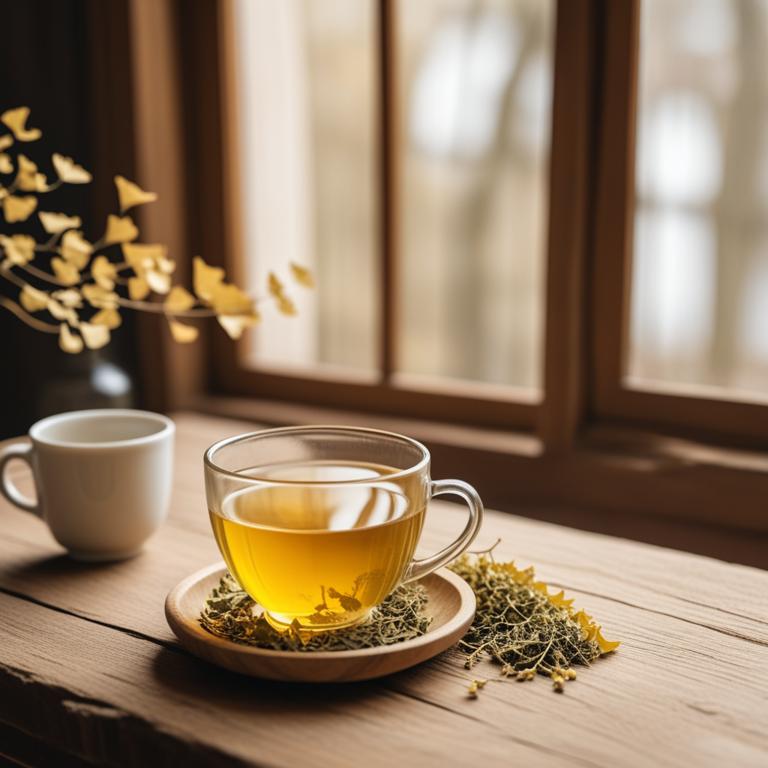
Ginkgo biloba teas have been traditionally used to treat period cramps due to their analgesic and anti-inflammatory properties, which help to alleviate discomfort and reduce pain.
The bioactive constituents, including flavonoids, terpenoids, and bilobalide, work together to relax uterine muscles, reduce prostaglandin production, and improve blood flow, thus providing relief from menstrual cramps.
The benefits of Ginkgo biloba teas in treating period cramps include reduced severity and frequency of episodes, improved mood, and enhanced overall well-being.
Regular consumption of Ginkgo biloba teas may also help to regulate menstrual cycles and reduce symptoms associated with premenstrual syndrome (PMS).
Related Study
According to the information provided, Ginkgo biloba teas for period cramps may be beneficial due to ginkgo's ability to exhibit therapeutic activity in various disorders, including congestive symptoms of premenstrual syndrome, likely attributed to its antioxidant properties and ability to enhance circulation.
Recipe:
- Gather 1 cup of boiling water and 1 teaspoon of dried Ginkgo biloba leaves.
- Measure 1 teaspoon of dried Ginkgo biloba leaves and put them in a tea infuser or a small muslin bag.
- Steep the Ginkgo biloba leaves in the boiling water for 5-7 minutes.
- Strain the tea into a cup and discard the Ginkgo biloba leaves.
- Drink the Ginkgo biloba tea 2-3 times a day to help relieve period cramps.
Ginkgo biloba teas can be used to treat period cramps, but may cause potential side effects such as dizziness, nausea, and headaches, especially when consumed in large quantities.
When using Ginkgo biloba teas to treat period cramps, it is essential to take precautions such as monitoring your body's reaction, avoiding excessive consumption, and keeping a stable diet to minimize the risk of side effects.
Ginkgo Biloba Tea on Amazon
Tai Chi Think Sharp Energizing Tea (Ginseng Ginkgo Biloba) 12 Bags
Disclaimer: We earn a commission if you click this link and make a purchase at no additional cost to you.
9. Melissa officinalis teas
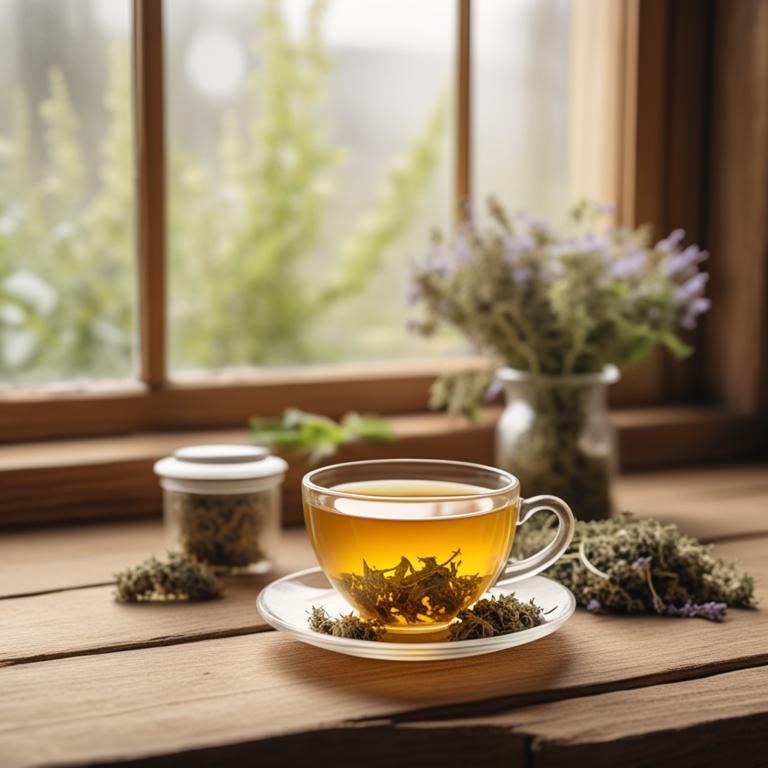
Melissa officinalis teas, also known as lemon balm tea, have been traditionally used to treat period cramps due to their analgesic, anti-inflammatory, and antispasmodic properties.
The tea helps to alleviate period cramps by relaxing the uterine muscles and reducing the production of prostaglandins, which are hormone-like substances that cause pain and inflammation.
The bioactive constituents of Melissa officinalis tea, including rosmarinic acid, melissic acid, and borneol, have been identified as the key compounds responsible for its pain-relieving and anti-inflammatory effects.
By consuming Melissa officinalis tea, women can experience relief from period cramps, improved mood, and reduced menstrual discomfort, making it a popular natural remedy for this common health issue.
Related Study
According to the study published in "Journal of ethnopharmacology", Melissa officinalis teas may not be directly linked to period cramps relief, but considering the study's findings on its anti-nociceptive properties, it suggests that Melissa officinalis teas could potentially be used to alleviate menstrual cramp pain by modulating opioidergic and serotonergic pathways.
Recipe:
- Gather 1 tablespoon of dried Melissa officinalis leaves and 1 cup of boiling water.
- Steep the Melissa officinalis leaves in the boiling water for 5-7 minutes.
- Strain the tea into a cup using a fine mesh sieve or a tea strainer.
- Add 1 tablespoon of honey to the tea, if desired, to sweeten the flavor.
- Drink the tea warm, 2-3 times a day, as needed to help alleviate period cramps.
Melissa officinalis teas can be an effective remedy for treating period cramps, but it may cause side effects such as drowsiness, stomach upset, and allergic reactions in some individuals.
To use Melissa officinalis teas safely, it is essential to start with a low dose, monitor your body's response, and avoid consuming it in large quantities or for extended periods, as this may exacerbate the potential side effects.
Melissa Officinalis Tea on Amazon
Maxx Herb Lemon Balm Extract - Max Strength Liquid Tincture Absorbs Better Than Capsules or Tea, for Nervous System Support, & Stress Management - Alcohol Free - 4 Oz Bottle (60 Servings)
Disclaimer: We earn a commission if you click this link and make a purchase at no additional cost to you.